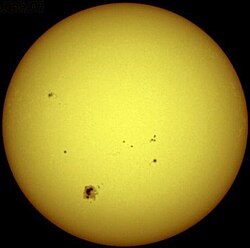Protuberans
En protuberans eller solfakkel er en stor og lysende dannelse, som udbreder sig fra Solens overflade, ofte i form af en løkke. Protuberanser har basis i solens overflade og strækker sig udad i Solens korona. Mens koronaen selv består af ekstremt varme og ioniserede gasser, kendt som plasma, og som ikke udsender særlig meget synligt lys, består protuberanser af meget køligere plasma, hvis sammensætning minder mere om kromosfærens. En protuberans dannes typisk inden for et tidsrum på en dag, og stabile protuberanser kan bestå i koronaen i adskillige måneder. Visse protuberanser splittes og giver anledning til udstødelse af koronamasse. Der pågår videnskabelige undersøgelser af, hvordan og hvorfor protuberanser dannes.
En typisk protuberans har en udstrækning på mange tusind kilometer. Den hidtil længste blev observeret af Solar and Heliospheric Observatory (SOHO) i 1997 og havde en længde på omkring 350.000 kilometer, [1] hvilket stort set er 28 gange Jordens diameter. Massen af det materiale, som en typisk protuberans omfatter, er i størrelsesordenen 100 milliarder ton.
Når en protuberans betragtes imod solskiven i stedet for mod rummet, syner den mørkere end den omgivende del af Solen og kaldes da et solfilament. [1] En udkastning af materiale kan være både et filament og en protuberans.[2] Flocculi (flertal af flocculus) er en anden betegnelse for disse filamenter, og mørke flocculi beskriver typisk protuberansers fremtræden, når de ses mod solskiven ved visse bølgelængder.
Galleri
- (c) I, Brocken Inaglory, CC-BY-SA-3.0
Protuberans.
- (c) I, Brocken Inaglory, CC-BY-SA-3.0
Frakoblet protuberans
- (c) I, Brocken Inaglory, CC BY-SA 3.0
Et randudbrud og efterfølgende protuberans.
Særlig stor protuberans (fra Skylab 1973).
Se også
Kilder
- ^ a b "Solar Filaments". Hentet 2010-01-02.
- ^ "About Filaments and Prominences (dansk: Om filamenter og protuberanser)". Hentet 2010-01-02.
Bibliografi
- Galsgaard, K.; Longbottom, A.W. (1999). "Formation of solar prominences by flux convergence". Astrophysical Journal. 510: 444. doi:10.1086/306559.
- Low, B.C.; Fong, B.; Fan, Y. (2003). "The mass of a solar quiescent prominence". Astrophysical Journal. 594: 1060. doi:10.1086/377042.
- Golub, L.; Pasachoff J.M. (1997). The Solar Corona. Cambridge University Press.
| |||||||||||||||||||||||||||||
|
Medier brugt på denne side
Carried by the Sun’s changing magnetic field, a filament, also known as a prominence of hot gas rose from the star’s surface. The event was observed by NASA’s Solar Terrestrial Reflection Observatory (STEREO) mission. STEREO consists of twin spacecraft that orbit the Sun, one spacecraft ahead of the Earth and the other following behind. The spacecraft that travels ahead of Earth captured this image. Viewed against the blackness of space, the prominence appears orange. The orange colour is especially bright near the Sun’s surface, but fainter wisps of orange also appear farther from the star. Instrument: SOHO
The Sun with some sunspots visible. The two small spots in the middle have about the same diameter as our planet Earth.
The STEREO (Ahead) spacecraft observed this visually stunning solar prominence eruption on September 29, 2008, in the 304 angstrom wavelength of extreme UV light. Prominences are relatively cool clouds of gas suspended above the sun and controlled by magnetic forces. The prominence rose and cascaded to the right over several hours, appearing something like a flag unfurling, as it broke apart and headed into space. The prominence is composed of ionized Helium that is about 60,000 degrees Kelvin.
(c) I, Brocken Inaglory, CC-BY-SA-3.0
Detached Solar Prominence.The solar disk was blocked in PS for a better visual effect.
A 1973 photograph of the Sun from Skylab, showing one of the "largest eruptive prominences in recorded history" (as of 1998).
(c) I, Brocken Inaglory, CC-BY-SA-3.0
Solar Prominence. The solar disk was blocked in PS for a better visual effect.
(c) I, Brocken Inaglory, CC BY-SA 3.0
The flare and so called after-flare Solar Prominence.The solar disk was blocked in PS for a better visual effect.
Forfatter/Opretter: NASA Goddard Space Flight Center from Greenbelt, MD, USA, Licens: CC BY 2.0
A movie of the March 30, 2010 prominence eruption, starting with a zoomed in view. The twisting motion of the material is the most noticeable feature. The viewpoint then pulls out to show the entire Sun.
Credit: NASA/GSFC/SVS/SDO
To read more about this video go to: www.nasa.gov/mission_pages/sdo/news/first-light.html
NASA Goddard Space Flight Center is home to the nation's largest organization of combined scientists, engineers and technologists that build spacecraft, instruments and new technology to study the Earth, the sun, our solar system, and the universe.Carried by the Sun’s changing magnetic field, a filament, also known as a prominence of hot gas rose from the star’s surface. The event was observed by NASA’s Solar Terrestrial Relations Observatory (STEREO) mission. STEREO consists of twin spacecraft that orbit the Sun, one spacecraft ahead of the Earth and the other following behind. The spacecraft that trails behind Earth captured this image. Instrument: SOHO

















